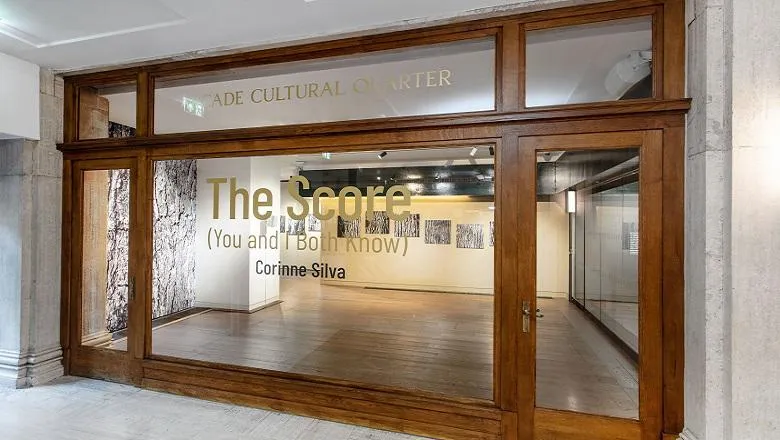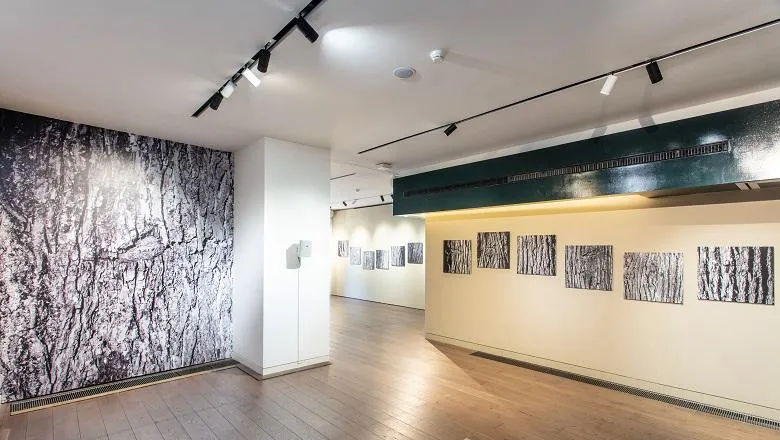The Score (You and I Both Know)
A new exhibition by Corinne Silva. Curated by Cécile Bourne-Farrell and Professor Vivienne Jabri.
27 February 2023
A PhD student from the Department of English reflects on the artwork presented in The Score (You and I Both Know).

Samantha Seto, student digital coordinator at King’s Culture and PhD student in the Department of English, Faculty of Arts & Humanities reviews The Score (You and I Both Know). The Score is currently in its last week on display at The Arcade, Bush House.
The wonderful art exhibition “The Score (You and I Both Know)” in The Arcade, Bush House presents a collection of grayscale photographs that illustrate the critical impact and aftermath of war. The artwork is part of a research project titled “Conflict and Injury” from the Department of War Studies which examines how war is fatal and inflicts great pain on the soldiers, landscapes, communities, and their lived experience in a myriad of historical settings. It is hosted by Professor of International Politics, Vivienne Jabri, and King’s Culture, in collaboration with the artist Corinne Silva and curator Cécile Bourne-Farrell.
As I walked through the doors of The Arcade, I observed photographs lining the walls that primarily featured scenes from nature: tree bark. I imagined the artist was inspired to portray war that inflicts world suffering. The art illustrates the historical conflict of the Bosnian War due to non-negotiable peace that led to many of the Slavic countries’ independence from Yugoslavia. The theme of injury is depicted on the bodies of Sarajevo’s citizens and the trees. The etching into the tree bark has constructed patterns that parallel the injury on the wounded bodies of soldiers on the battleground during the war.

The Bosnian War is displayed in the photographs through the images of tree bark, landscape, and hospitalised bodies that emphasise the themes of memory, solidarity, and resilience. In the siege of Sarajevo, the capital city’s wall barrier was positioned as a shield for protection because the city had been previously besieged by the Yugoslavian army. The siege of Sarajevo endured the longest in the entire history of modern warfare. Bosnia declared independence from Yugoslavia in the early twentieth century. In 1995, the war ultimately ended with a compromise and the signing of the Dayton Accords. As I bridged the connection of the Bosnian War to the photographs, I reflected on my nice visit a couple of summers ago to Dubrovnik in Croatia, and in particular, travelling to a new country in the Balkans – Bosnia. On a warm day with clear blue skies, I was a tourist with my family being driven along rocky cliffs above the Adriatic Sea. In the gallery, I remembered crossing the national border, and I thought about the rich history and beautiful nature in the land of Bosnia.
The writing on the gallery wall is from a Yugoslav Partisan song written during the Second World War. My favourite verse of the anthem is “cannons fire in the forest / and the stars are playing in the sky”, because the nature imagery in the language articulates the powerful effect of the war. The installation also features sound that allows viewers to think of the siege of Sarajevo and provides an auditory cartography of violence. Whilst listening to the music, I empathised with the pain, misery, and terror experienced by the soldiers in the war. In the musical score, bullets and shrapnel are audible with a metal detector, and it is interwoven into the Yugoslav Partisan song in the soundscape.
The exhibition is a testimony to the resistance of the destruction to the civilians during the war and it captures nature and violent images in photographs in addition to the melodic sound of lived experience during the historical moment and great impact of the war. Conflict and injury in artwork has resonated across the years and is still relevant to the lasting impact of wars in the present day. In all, the artwork offered a compelling historical narrative and a creative, artistic space for all King’s students to appreciate.
The Score (You and I Both Know) is a free exhibition supported by King's Culture, and is part of the inaugural artistic programme in the Strand Cultural Quarter since the official opening of the Strand Aldwych pedestrianisation. The Strand Cultural Quarter at King’s supports creative learning, showcases imaginative research collaborations and invites local communities to connect with the university through a varied programme of events and activities.
The Score (You and I Both Know)
Dates: 7 February – 3 March 2023
Opening times: Monday to Saturday, 10:00 – 18:00
Address: The Arcade, Bush House South Entrance, King’s College London, Strand, London, WC2B 4PJ
Free entry
A new exhibition by Corinne Silva. Curated by Cécile Bourne-Farrell and Professor Vivienne Jabri.